Reminders of Rome in Macaron-Colored Arles, France
Bundling up in boots, skinny jeans, and scarves while spending Thanksgiving with family a couple weeks ago in Indiana reminded me of the last time the weather was that cold: late February, when my friend Melissa and I traveled around southern France from our home base in Avignon. We were so fed up with the miserable cold, rainy weather in Santiago de Compostela that we decided to hop on over to France’s Mediterranean coast—where you would think things would be warm and sunny—only to be greeted with more rain and cold weather. I guess you can’t have everything.
But it’s easy to beat the winter blues when you’re in one of the most beautiful parts of Europe, rain or shine. Avignon welcomed us in for four nights and turned out to be a cozy city overflowing with history. We took advantage of Avignon’s central location and good rail connections to make daytrips to various towns around Provence, once of which was the Roman city of Arles, a mere 17-minute journey on the speedy TER train.
In its heyday during the Roman Empire, Arelate was one of the premier cities of the Mediterranean, even eclipsing Marseilles as the major port city for southern Gaul. Marseilles has long since regained that status, while Arles remains a mid-sized town of 50,000. Fortunately for us, much of its Roman heritage still remains, and the old town’s most bustling city square sits on what would have been the Roman forum 2,000 years ago.
The most striking relic from Roman times has to be the amphitheater, a miniature Colosseum designed for gladiator fights and chariot races. It’s truly impressive how much of the original arena has lasted over two millennia—but let’s not forget that the Romans were never keen on making disposable buildings that could be torn down in 50 years; instead, their building projects were intended to awe, impress, and endure.
Most of these public works projects outlasted the empire itself, which collapsed in the mid-400s CE. Others, however, like the theater, were not so lucky. A setting for plays and other dramatic performances, Arles’ Roman theater simply dissolved over the centuries, with its gleaming white columns and stairstep seating being repurposed as building materials for houses.
I enjoyed crawling around the Roman amphitheater, but descending underground beneath the town hall was even better, as I got to explore the city’s cryptoportico. Functioning essentially as a foundation for the forum above, the cryptoportique supported the weight of heavy monuments like a temple or colonnaded walls using that signature Roman feature, the arch. Barrel vaults span all four of the cryptoportico’s dim, dank halls, where water drips down and the silence is thick and heavy. Almost as an afterthought, fragments of 2,000-year-old columns and other stonework lined the walls in the shadows.
When the Roman Empire came to an end, major building projects came to a standstill as well, as most folks were more concerned with fortifying their cities from barbarians than putting up grandiose public works. But the chaos of the post-imperial era—a.k.a the “Dark Ages”—eventually gave way to somewhat-stable kingdoms where noblemen and Catholic bishops wielded a lot of power in a feudal society. When it came time for them to build palaces or churches, they looked back to the crumbling Roman monuments all around them and drew on the artistic heritage from centuries past…creating buildings that weren’t properly Roman, but Roman-esque.
The Romanesque was the first major architectural style that buildings were designed in as what we know today as “Europe” emerged from the ruins of the Roman Empire and the old barbarian kingdoms. Architects used that classic Roman semicircular arch everywhere they could: doorways, tiny windows, barrel-vaulted ceilings, wall supports, and covered walkways lined with arcades. Triumphal arches reappeared in grand, symmetrical entrances and decorated façades, while solid, heavy walls and columns recalled the sheer big-ness of Roman buildings.
The Church of Saint-Trophime stands as the best example of the Romanesque style in Arles. Opening out onto the Place de la République, the church’s west façade is basically one huge triumphal arch—but instead of sculptures depicting Roman emperors dragging their conquered subjects through the streets of Rome, you see Christ seated in judgment, surrounded by angels and the apostles, while sinners march in a conga line into Hell where demonic lions munch on people for dinner.
I was really impressed with the cloisters out back, which were surrounded on all four sides by arcades supported by two columns each—and every single column was topped with an intricately-carved capital depicting scenes from the Bible or medieval mythical creatures. Truly stunning!
When I first heard about Arles, I was really intrigued that not only did the city use their Roman amphitheater as an arena for French-style bullfighting, but they also put what was left of their old Roman theater to use as a venue for plays and musical performances, reviving their ancient, intended purposes.
During my pre-trip research, I expected to read that medieval Arlesians used the theater as a public quarry of free, quality, pre-cut stones to use for their houses and churches, but I was really surprised when I learned that, when the Empire collapsed, citizens retreated into the amphitheater and used it as a castle to protect themselves against marauding invaders. Authorities put up four lookout towers—three of which are still there—and locals built houses within the amphitheater’s walls. This “neighborhood” lasted well into the 1800s, until the city took over the area, excavated the ruins, and restored the arena in 1830.
The icing on the cake of all these historical monuments was the colorful old town of Arles itself, pronounced “arl” [aʁl] in modern French. Pastel-colored shutters complemented earth-toned houses with clay-tiled roofs. Flowers bloomed from window sill planters, and bright awnings offered protection from threatening drizzles. In short, it was a pleasant change from the gray-and-white world of Santiago de Compostela.
Painter Vincent van Gogh lived in Arles for two years, drawn by the warm, inviting light that bathes the region. Here he painted hundreds of works, including such famous pieces as Café Terrace at Night, Bedroom in Arles, and Starry Night Over the Rhône. While the city’s tourism board milks the Van Gogh angle for all its worth, you can’t find any paintings by the artist in any of Arles’ museums, sadly.
Nevertheless, my travel buddy Melissa and I enjoyed strolling through the narrow streets, stopping off at a French-Moroccan fusion joint for galettes and crêpes, peeking into a corner café to sip on tiny coffee cups of hazelnut-colored noisettes, and slurping down bowls of phở at a Vietnamese restaurant near the old northern city gates.
Do you care more about ancient monuments or modern, trendy shops and eateries when traveling? Tell me about your travel style below in the comments!

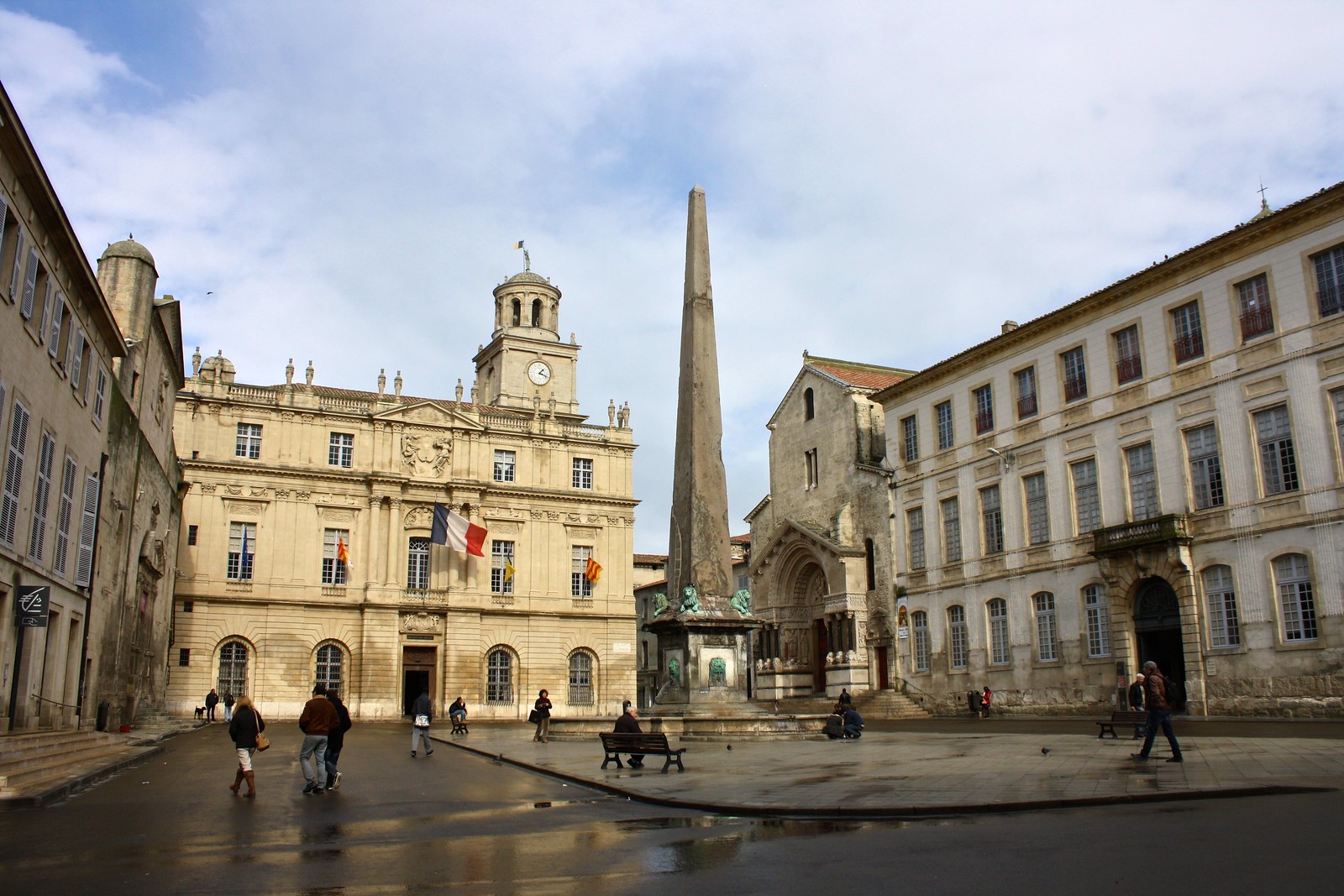 |
| Place de la République |
But it’s easy to beat the winter blues when you’re in one of the most beautiful parts of Europe, rain or shine. Avignon welcomed us in for four nights and turned out to be a cozy city overflowing with history. We took advantage of Avignon’s central location and good rail connections to make daytrips to various towns around Provence, once of which was the Roman city of Arles, a mere 17-minute journey on the speedy TER train.
Ghosts from the Roman Empire
 |
| The amphitheater |
In its heyday during the Roman Empire, Arelate was one of the premier cities of the Mediterranean, even eclipsing Marseilles as the major port city for southern Gaul. Marseilles has long since regained that status, while Arles remains a mid-sized town of 50,000. Fortunately for us, much of its Roman heritage still remains, and the old town’s most bustling city square sits on what would have been the Roman forum 2,000 years ago.
 |
| Inside the ampitheater arches |
The most striking relic from Roman times has to be the amphitheater, a miniature Colosseum designed for gladiator fights and chariot races. It’s truly impressive how much of the original arena has lasted over two millennia—but let’s not forget that the Romans were never keen on making disposable buildings that could be torn down in 50 years; instead, their building projects were intended to awe, impress, and endure.
 |
| Fragments of decorative cornice |
Most of these public works projects outlasted the empire itself, which collapsed in the mid-400s CE. Others, however, like the theater, were not so lucky. A setting for plays and other dramatic performances, Arles’ Roman theater simply dissolved over the centuries, with its gleaming white columns and stairstep seating being repurposed as building materials for houses.
 |
| Cryptoportico |
I enjoyed crawling around the Roman amphitheater, but descending underground beneath the town hall was even better, as I got to explore the city’s cryptoportico. Functioning essentially as a foundation for the forum above, the cryptoportique supported the weight of heavy monuments like a temple or colonnaded walls using that signature Roman feature, the arch. Barrel vaults span all four of the cryptoportico’s dim, dank halls, where water drips down and the silence is thick and heavy. Almost as an afterthought, fragments of 2,000-year-old columns and other stonework lined the walls in the shadows.
Roman architecture’s rebirth in the Romanesque
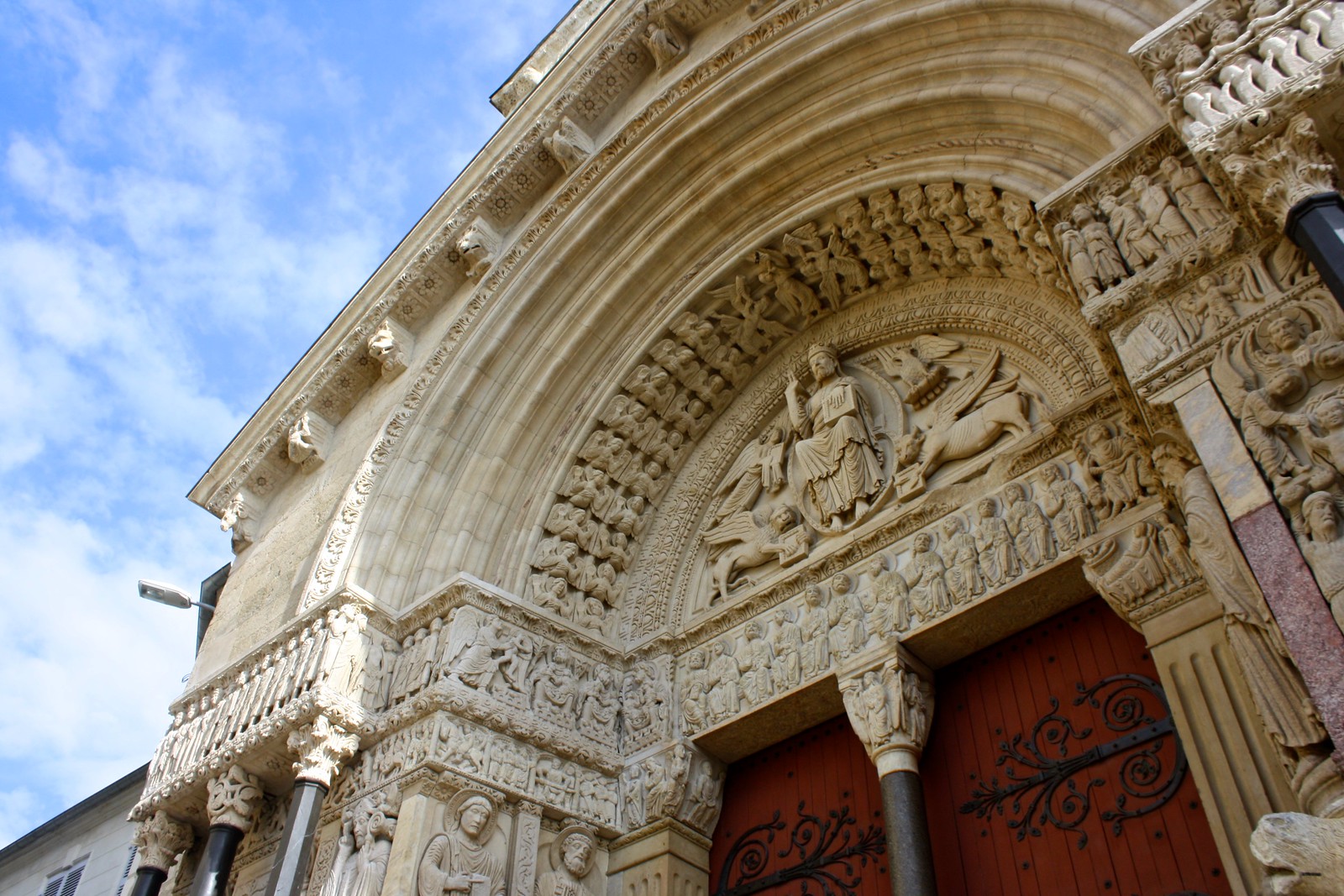 |
| Main façade, Church of St-Trophime |
When the Roman Empire came to an end, major building projects came to a standstill as well, as most folks were more concerned with fortifying their cities from barbarians than putting up grandiose public works. But the chaos of the post-imperial era—a.k.a the “Dark Ages”—eventually gave way to somewhat-stable kingdoms where noblemen and Catholic bishops wielded a lot of power in a feudal society. When it came time for them to build palaces or churches, they looked back to the crumbling Roman monuments all around them and drew on the artistic heritage from centuries past…creating buildings that weren’t properly Roman, but Roman-esque.
 |
| Statues and sculptures |
The Romanesque was the first major architectural style that buildings were designed in as what we know today as “Europe” emerged from the ruins of the Roman Empire and the old barbarian kingdoms. Architects used that classic Roman semicircular arch everywhere they could: doorways, tiny windows, barrel-vaulted ceilings, wall supports, and covered walkways lined with arcades. Triumphal arches reappeared in grand, symmetrical entrances and decorated façades, while solid, heavy walls and columns recalled the sheer big-ness of Roman buildings.
 |
| Cloisters |
The Church of Saint-Trophime stands as the best example of the Romanesque style in Arles. Opening out onto the Place de la République, the church’s west façade is basically one huge triumphal arch—but instead of sculptures depicting Roman emperors dragging their conquered subjects through the streets of Rome, you see Christ seated in judgment, surrounded by angels and the apostles, while sinners march in a conga line into Hell where demonic lions munch on people for dinner.
I was really impressed with the cloisters out back, which were surrounded on all four sides by arcades supported by two columns each—and every single column was topped with an intricately-carved capital depicting scenes from the Bible or medieval mythical creatures. Truly stunning!
The restored Roman monuments
 |
| Modern bullfighting arena |
When I first heard about Arles, I was really intrigued that not only did the city use their Roman amphitheater as an arena for French-style bullfighting, but they also put what was left of their old Roman theater to use as a venue for plays and musical performances, reviving their ancient, intended purposes.
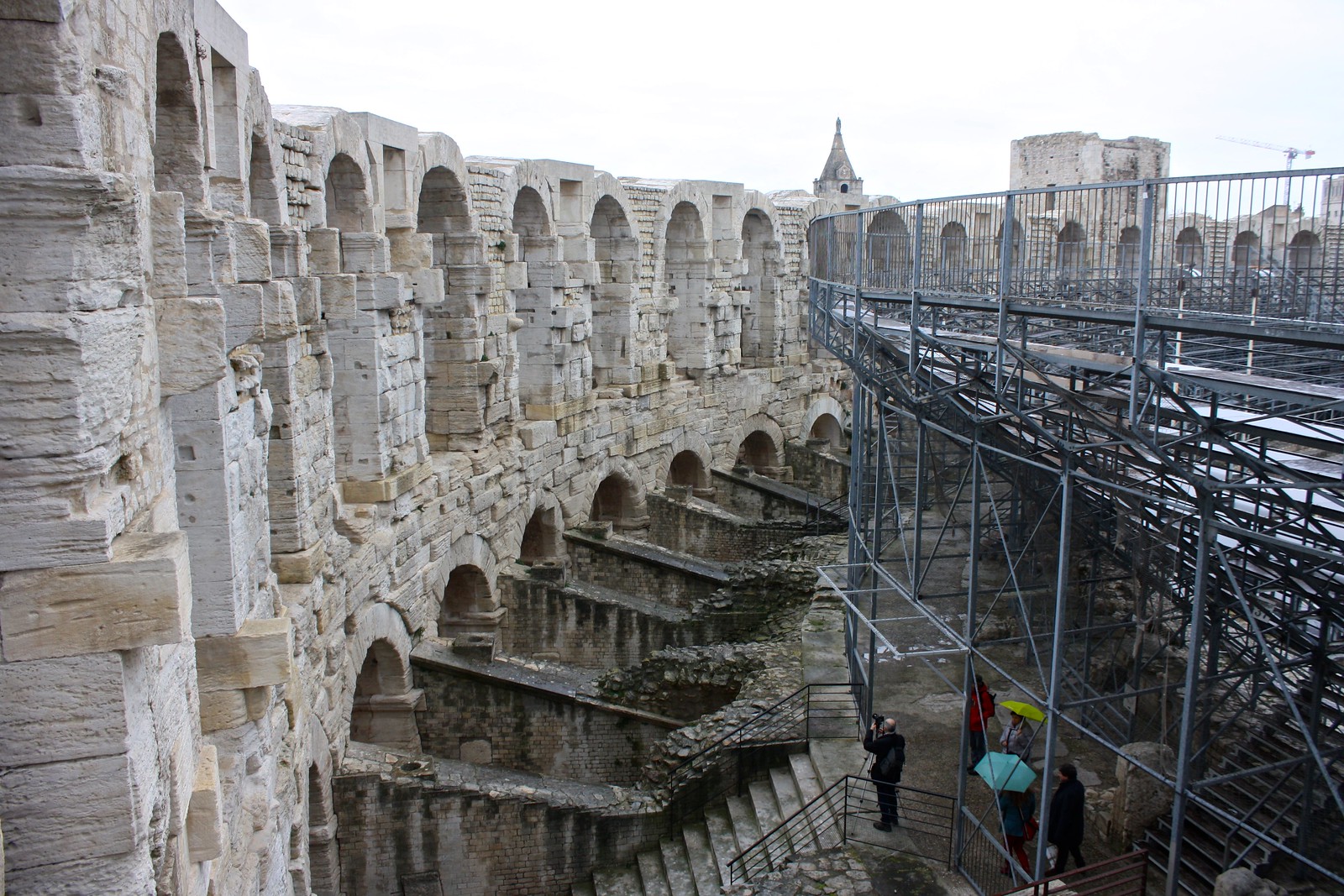 |
| Modern grandstands |
During my pre-trip research, I expected to read that medieval Arlesians used the theater as a public quarry of free, quality, pre-cut stones to use for their houses and churches, but I was really surprised when I learned that, when the Empire collapsed, citizens retreated into the amphitheater and used it as a castle to protect themselves against marauding invaders. Authorities put up four lookout towers—three of which are still there—and locals built houses within the amphitheater’s walls. This “neighborhood” lasted well into the 1800s, until the city took over the area, excavated the ruins, and restored the arena in 1830.
 |
| Modern theatrical stage |
The pretty town of Arles
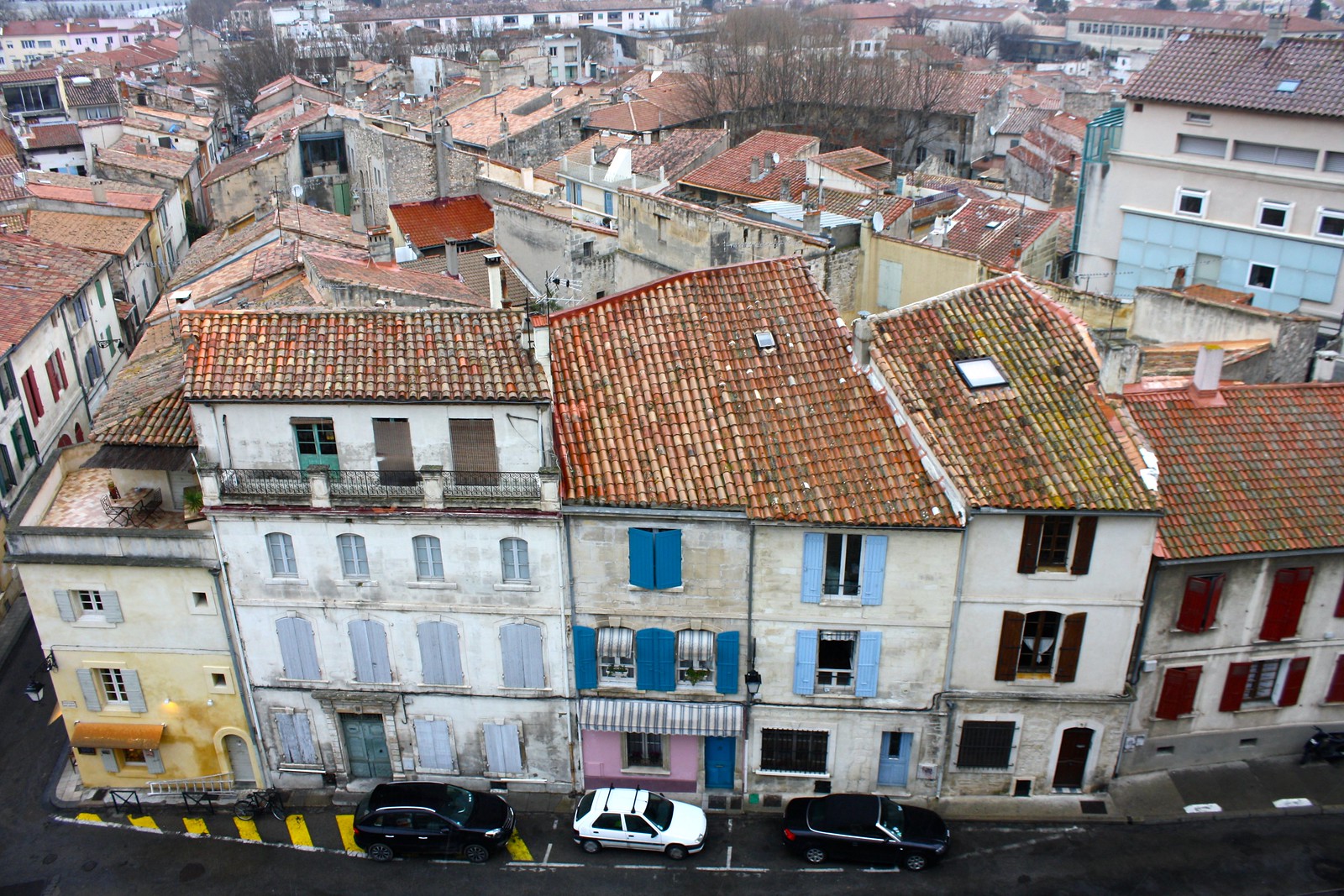 |
| The old town, seen from on top of the amphitheater |
The icing on the cake of all these historical monuments was the colorful old town of Arles itself, pronounced “arl” [aʁl] in modern French. Pastel-colored shutters complemented earth-toned houses with clay-tiled roofs. Flowers bloomed from window sill planters, and bright awnings offered protection from threatening drizzles. In short, it was a pleasant change from the gray-and-white world of Santiago de Compostela.
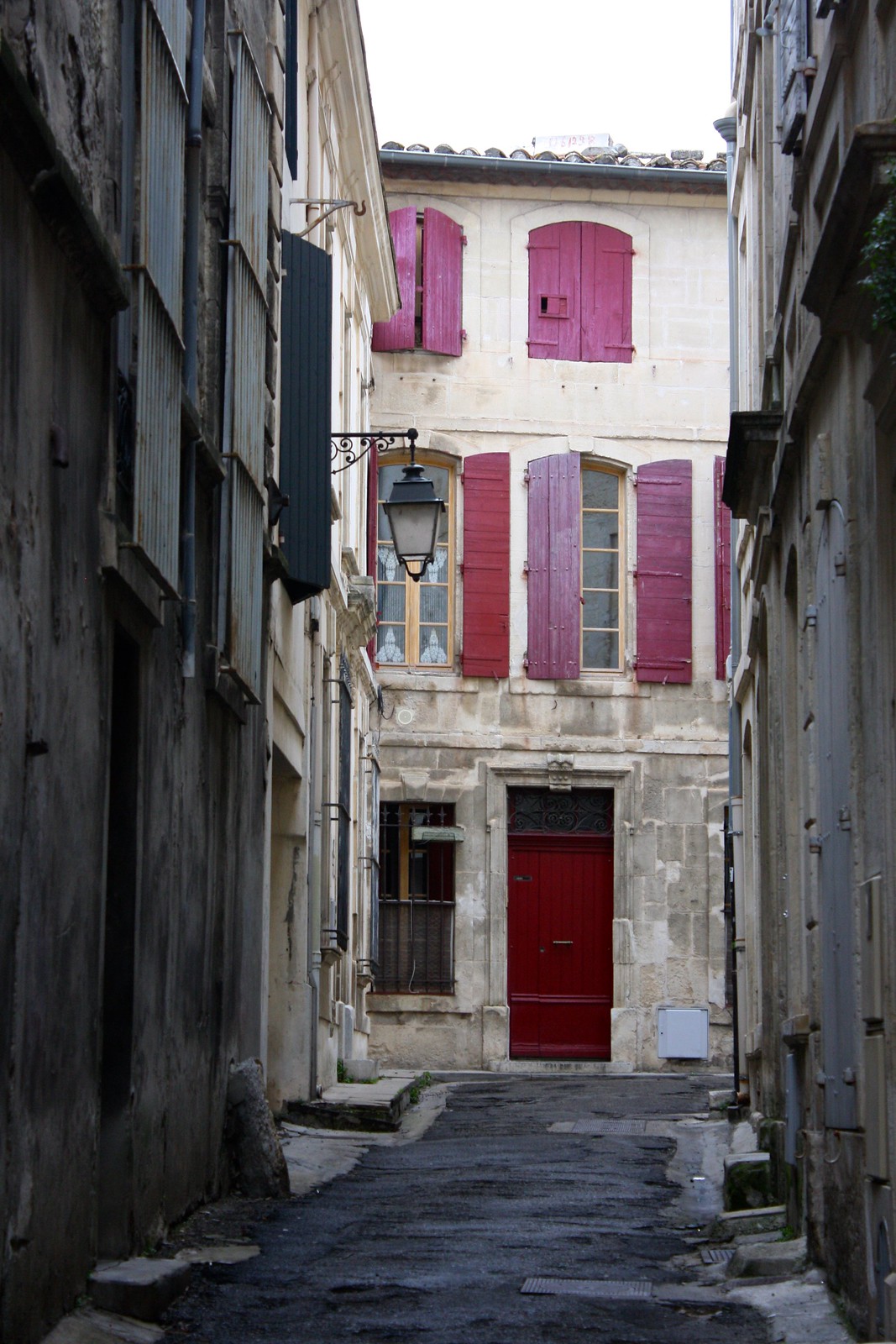 |
| Light and shadow |
Painter Vincent van Gogh lived in Arles for two years, drawn by the warm, inviting light that bathes the region. Here he painted hundreds of works, including such famous pieces as Café Terrace at Night, Bedroom in Arles, and Starry Night Over the Rhône. While the city’s tourism board milks the Van Gogh angle for all its worth, you can’t find any paintings by the artist in any of Arles’ museums, sadly.
Nevertheless, my travel buddy Melissa and I enjoyed strolling through the narrow streets, stopping off at a French-Moroccan fusion joint for galettes and crêpes, peeking into a corner café to sip on tiny coffee cups of hazelnut-colored noisettes, and slurping down bowls of phở at a Vietnamese restaurant near the old northern city gates.
 |
| Sunset over the Rhône River |
Do you care more about ancient monuments or modern, trendy shops and eateries when traveling? Tell me about your travel style below in the comments!


